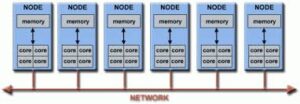Introduction | Pthreads | Programming & Parallel Computing Resources
In the world of modern computing, efficiency and speed are not just advantages—they are necessities. As applications become more complex and the demand for high-performance systems grows, developers must find ways to fully harness the power of today’s multi-core processors. One of the most powerful tools available for this task is POSIX Threads, more commonly known as Pthreads.
Pthreads provide a standardized and flexible way to implement multithreading in C and C++ programs. By enabling multiple parts of a program to run concurrently, Pthreads allow developers to build software that is faster, more responsive, and capable of handling workloads that would otherwise be overwhelming for single-threaded applications. Whether you are working on scientific simulations, data processing pipelines, or real-time systems, understanding Pthreads is a valuable skill for any programmer.
What Are Pthreads?
Pthreads are an API (Application Programming Interface) defined by the POSIX (Portable Operating System Interface) standard. They were designed to make parallel programming portable across different Unix-like operating systems, such as Linux, macOS, and BSD. Instead of writing platform-specific threading code, developers can rely on Pthreads to ensure consistency and reliability.
In simple terms, Pthreads allow programmers to divide tasks into threads, which are lightweight execution units within a process. These threads can share memory and resources, while still operating independently. This makes it possible to run multiple tasks in parallel without the overhead of creating multiple separate processes.
Why Use Pthreads?
-
Performance – By splitting large tasks into smaller, concurrent threads, programs can run faster and make better use of modern CPUs.
-
Scalability – Pthreads make it easier to build applications that can grow with hardware improvements, taking advantage of additional cores.
-
Responsiveness – In applications like user interfaces or servers, threads can keep programs responsive by handling background tasks while the main thread processes user input.
-
Portability – Because Pthreads are based on a standard, code that uses them can often be compiled and run across multiple platforms with little or no modification.
Core Concepts of Pthreads
To effectively use Pthreads, developers need to understand several core concepts:
-
Thread Creation and Management: Functions like
pthread_create()andpthread_join()control when threads start and how they synchronize with each other. -
Synchronization: Mechanisms such as mutexes, condition variables, and barriers ensure that threads can safely share resources without data corruption.
-
Thread Safety: Writing thread-safe code requires careful handling of shared variables and avoiding race conditions.
-
Concurrency vs. Parallelism: While concurrency allows tasks to progress simultaneously, parallelism ensures they run on separate cores for maximum performance.
Real-World Applications of Pthreads
Pthreads are widely used in areas where performance and responsiveness matter most:
-
High-Performance Computing (HPC) – Scientific modeling, simulations, and large-scale data analysis.
-
Operating Systems and Kernels – Many system services rely on threads for efficiency.
-
Web Servers – Handling multiple client requests simultaneously with minimal resource overhead.
-
Real-Time Applications – Robotics, multimedia processing, and control systems where timing is critical.
Conclusion
Pthreads remain one of the most reliable and widely adopted tools for building parallel and concurrent applications in C and C++. Their balance of portability, flexibility, and efficiency makes them essential for developers who aim to push the boundaries of performance in modern computing.
This resource hub—Pthreads | Programming & Parallel Computing Resources—is designed to help programmers explore the fundamentals, best practices, and advanced techniques of multithreading. Whether you are a student just learning about concurrency or a professional optimizing high-performance systems, mastering Pthreads will open the door to faster, smarter, and more scalable software.
